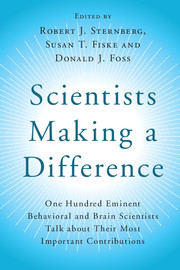 Scientists Making a Difference
Scientists Making a Difference from Section A - Cognitive Development
Published online by Cambridge University Press: 05 August 2016
My most important scientific contribution concerns the development of “source misattributions.” That's a fancy term to describe an event that is familiar, but not because we actually experienced it. Instead, it's familiar to us because in the past we either imagined it, or read about it, or saw something related to it on television, or overheard a conversation about it. These prior mental activities reside in memory but sometimes without their source: is this event familiar because I truly experienced it, or is the source of its familiarity having imagined it or heard someone talking about it? Although we all have a propensity for misattributing the source of why something is familiar, very young children are most vulnerable. It turns out that a lot of really important phenomena are related to it, including court cases involving child witnesses.
You may find the way I became interested in source misattributions interesting. In graduate school I studied children's memory. By the time I got my PhD I thought I knew a lot about how children remember. But I was jolted into reality one day when a judge from upstate New York called me at my office at Cornell. He had a case in his courtroom involving a child's recollection that puzzled him. He said someone gave him my name as an expert on children's memory. The gist of the case was as follows: a woman disappeared when her son was twenty-two months old. After several months had passed, and the mother did not return home, her husband took their son to his missing wife's sister and asked her to care for the child. The aunt and father had not had a good relationship, and they were known to have argued vehemently about his mistreatment of her sister. The aunt agreed to care for her nephew until her sister resurfaced. The father moved to Florida, and his contact with his son and sister-in-law was limited. He remarried eventually.
At the time of the judge's phone call, the boy had been living with his aunt for four years. The house in which the boy lived with his parents had been sold and resold, and the newest owners were adding an extension when the excavator discovered the skeletal remains of the missing mother. The coroner's report indicated she had been killed by blunt force trauma to her head by a rounded object.
To save this book to your Kindle, first ensure no-reply@cambridge.org is added to your Approved Personal Document E-mail List under your Personal Document Settings on the Manage Your Content and Devices page of your Amazon account. Then enter the ‘name’ part of your Kindle email address below. Find out more about saving to your Kindle.
Note you can select to save to either the @free.kindle.com or @kindle.com variations. ‘@free.kindle.com’ emails are free but can only be saved to your device when it is connected to wi-fi. ‘@kindle.com’ emails can be delivered even when you are not connected to wi-fi, but note that service fees apply.
Find out more about the Kindle Personal Document Service.
To save content items to your account, please confirm that you agree to abide by our usage policies. If this is the first time you use this feature, you will be asked to authorise Cambridge Core to connect with your account. Find out more about saving content to Dropbox.
To save content items to your account, please confirm that you agree to abide by our usage policies. If this is the first time you use this feature, you will be asked to authorise Cambridge Core to connect with your account. Find out more about saving content to Google Drive.